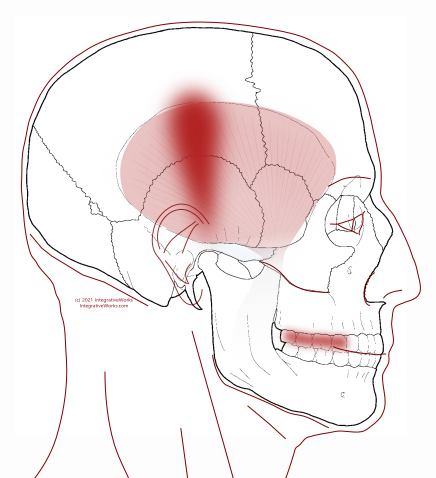Headache Above/ Behind Ear Wearing Hat
Table of Contents
- How People Describe This Pain Pattern
- How You Activate and Intensify This Pain Pattern
- Self-Care – Getting Relief on Your Own
- Musculoskeletal Anatomy Behind Your Pain
- Therapy Notes for Massage and Bodywork
Want to skip ahead?
Here’s a link to my post about
getting relief on your own.
How People Describe This Pain Pattern
Here, you’ll find information about the two trigger points that create headaches on the side of the head, above, and behind the ear.
There are 3 or 4 headache patterns that come off the trigger points in the temporalis. Each one has a band of pain that extends upward. And, most associate with sensitivity in the upper teeth. Like the bands of pain, the trigger points in the front create sensitivity in the front teeth, and the trigger points in the back create sensitivity in the back teeth.


Pain Over the Ear
People complain of a strip of pain above or behind the ear. Mainly, it occurs when a hat presses into the side of their head. When the headache is directly over the ear, there is often tooth sensitivity in their upper molars. However, people seldom mention these tooth problems to the bodyworker – unless that bodyworker specializes in cranial work.
When suspected, the bodyworker feels for a taut strip of muscle extending away from the ear toward the band of pain.
Pain Behind the Ear
This strip of headache behind the head comes from a band of tight muscle behind the ear. A tight band is almost always palpable and tender to the touch. Just feeling for the tight band often aggravates the headache.
Very Similar Pain Pattern, Different Muscle
The pattern in this post can also feel like it is above or behind the ear. This one can also feel a lot like a migraine. However, hats don’t bother these people. Instead, they often wear a hat to reduce headaches by shielding their eyes.
The pattern is, however, quite different. Instead of a strip up the side of the head, this feels more like a band through the top of the ear.
Also, if this comes from bumping your head, you probably hit the front and snapped your head back.
How You Activate and Intensify This Pain Pattern
Bumping Your Head or Overworking Your Jaw
These two trigger points are more likely to be caused by a blow to the head and aggravated by a tight headband. They, of course, also get irritated by dentistry or chewing something like ice or taffy. However, this usually comes from a sharp blow to the side or back of the head. Also, it usually involves something hard like a baseball or the corner of a cabinet.
The Musculoskeletal Anatomy Behind Your Pain
Musculoskeletal Anatomy
This post on anatomy contains standard information about the origin, insertion, function, and innervation of muscles. Additionally, it includes information on functional considerations and anomalies.
Find Related Posts
Anatomy posts have a grid of all related posts. This includes posts on pain patterns, self-care, therapy notes, NMT protocols, cranial techniques, and cases.
Getting Relief on Your Own
Clinically Proven
Self-Care Strategies
Self-Care Posts have common sections to make them easy to follow and understand:
- Activities to Avoid or Change
- Strategies for Quick Relief
- Stretches and Exercise for Longer-Lasting Relief
- Yoga Corner
Therapy Notes for Massage and Bodywork
Better Bodywork
Through Shared Expertise
Therapy Notes provide details for cranial, spinal, and local joint work. These notes also link to a traditional neuromuscular protocol.
By treating integrative components first, direct work on the muscle becomes less intense while providing longer-lasting relief.
Support Integrative Works to
stay independent
and produce great content.
You can subscribe to our community on Patreon. You will get links to free content and access to exclusive content not seen on this site. In addition, we will be posting anatomy illustrations, treatment notes, and sections from our manuals not found on this site. Thank you so much for being so supportive.
Cranio Cradle Cup
This mug has classic, colorful illustrations of the craniosacral system and vault hold #3. It makes a great gift and conversation piece.
Tony Preston has a practice in Atlanta, Georgia, where he sees clients. He has written materials and instructed classes since the mid-90s. This includes anatomy, trigger points, cranial, and neuromuscular.
Question? Comment? Typo?
integrativeworks@gmail.com
Follow us on Instagram
*This site is undergoing significant changes. We are reformatting and expanding the posts to make them easier to read. The result will also be more accessible and include more patterns with better self-care. Meanwhile, there may be formatting, content presentation, and readability inconsistencies. Until we get older posts updated, please excuse our mess.